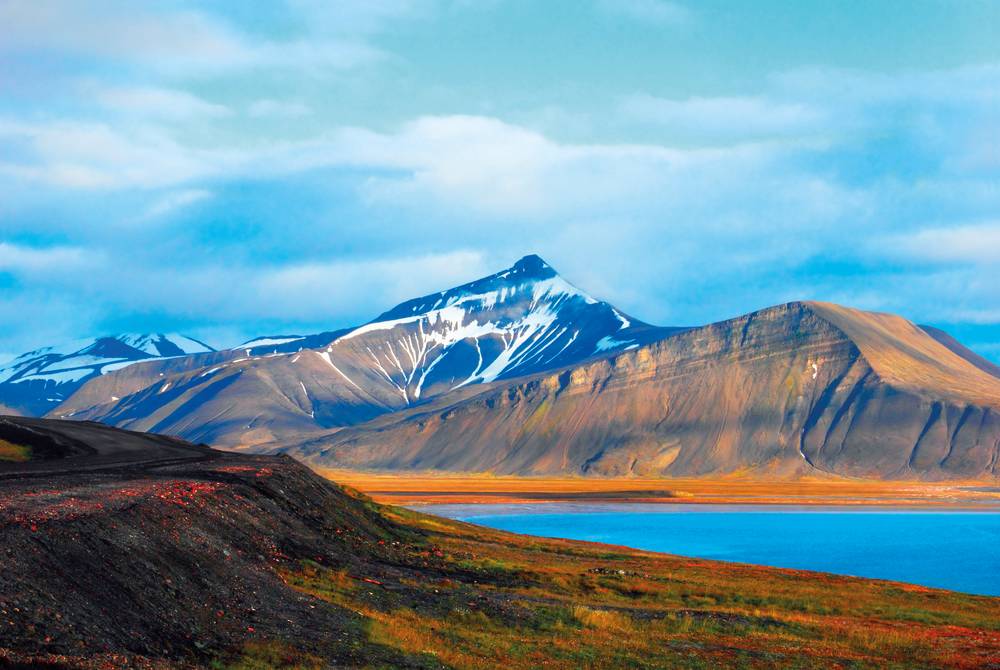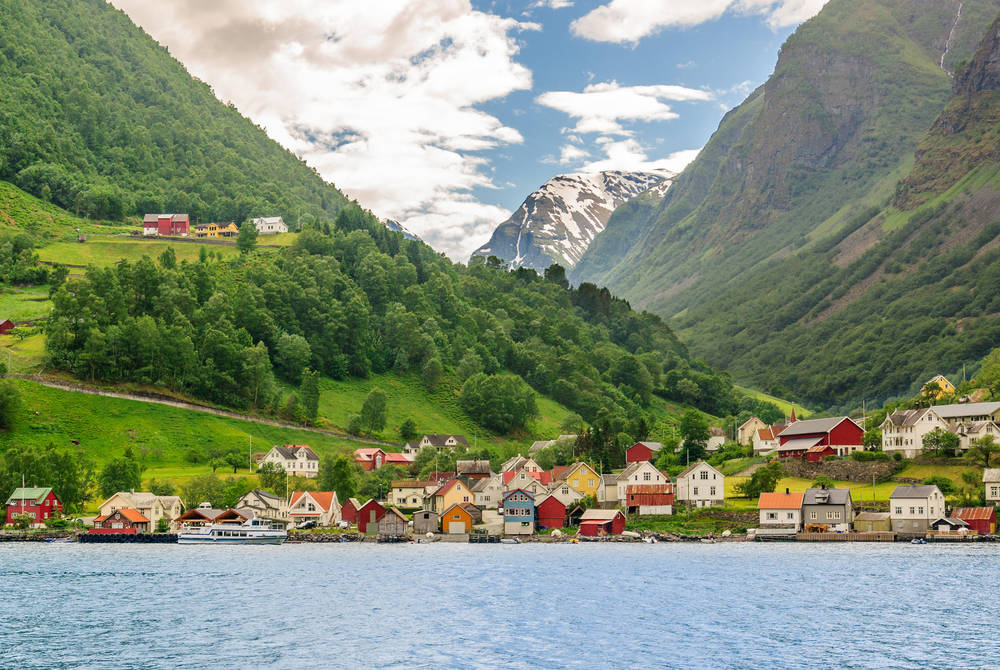Rising out of the Barents Sea, roughly halfway between mainland Norway and the North Pole is Svalbard, an archipelago of nine permanently frozen islands in the High Arctic. Most of it is pure, untouched wilderness, characterised by gigantic glaciers, rugged mountains, deep fjords and barren tundra. Outside of the main town, Longyearbyen (beyond which it is prohibited to wander without polar bear protection) and a handful of other tiny settlements, signs of human civilization are almost non-existent. Although part of the Kingdom of Norway, Svalbard feels very much like a world of its own. As such, it’s a true bucket list destination for many travellers seeking to explore the wildest and most extreme limits of Scandinavia. To point you in the right direction, here’s everything you need to know about planning a trip to Svalbard.
How to get there

Svalbard Airport: the northernmost airport in the world with regular commercial flights
Given just how remote it is, getting to Svalbard is surprisingly easy. Both Scandinavian Airlines and Norwegian operate regular flights to Longyearbyen from Oslo (three hours) and Tromso (an hour and a half). Typically, one would spend a night in either city before flying out to Svalbard the following day, although you could spend a little longer exploring either Oslo or Tromso before continuing your onward journey to Svalbard.
Bear in mind that although Svalbard is part of Norway, it is not part of the Schengen area, so you’ll go through passport control in either Oslo or Tromso on exiting and entering Schengen. Also, even if you’re on a direct flight from Oslo, it may make a short stop in Tromso en route. On arrival in Svalbard, it takes just 10 minutes to get from the airport to the centre of Longyearbyen by shuttle bus. Taxis are also available, but these are more expensive and only marginally quicker – there is no traffic in this part of the world.
When to go

There's no daylight in Svalbard from mid-November to mid-January
Svalbard experiences dramatic seasonal contrasts, so it’s crucial to carefully consider when to visit, depending on what you’re hoping to get out of your experience.
From around 20 April to 23 August, the sun doesn’t dip below the horizon at all, bathing Svalbard in perpetual daylight for more than four months. This is the Polar Summer, during which time the thawing of snow and ice opens the archipelago up for hiking, cycling and boat trips as temperatures stay comfortably above zero. Autumn is a brief but beautiful time in the High Arctic as the sunsets return, the tundra transforms into shades of gold and copper and the first dustings of snow arrive on the mountaintops.
The days rapidly shorten throughout October and by the end of the month, it sets for the last time in over 100 days, signalling the start of the Polar Night. However, it isn’t completely pitch black for this entire period; the darkest part is between mid-November and mid-January when the sun remains at least six degrees below the horizon and day and night merge into one. Towards the start and end of Polar Night, there’s an extended twilight period known as ‘Blue Hour’, when the sun isn’t up but there’s a gorgeous blue light for several hours around the middle of the day.

February is one of the best months to visit Svalbard
The days become gradually lighter throughout February and in early March, the locals celebrate the return of the sun as its rays finally emerge over the mountaintops. This period, from February to April, is a particularly opportune time to visit Svalbard, as there’s ample daylight and widespread snow cover for the activities including snowmobiling and husky sledding (which usually aren’t possible in the early months of Polar Night). Temperatures of -10°C to -20°C are fairly typical in winter – cold, but less so than other places at similar latitudes due to the warming effect of the Gulf Stream. This mostly impacts Svalbard’s west coast, where Longyearbyen is, while the uninhabited east coast tends to see significantly colder temperatures and more sea ice. Temperatures can dip below -30°C during especially cold periods, so packing plenty of quality layers is essential.
Discover Svalbard in Polar Night
Can you see the Northern Lights?

The Northern Lights are a regular occurrence in Svalbard in winter
Yes, you can absolutely see the Northern Lights in Svalbard, although it isn’t necessarily the best place to go if that’s your main aim. This is because Svalbard is so far north (Longyearbyen sits at 78˚N) that it’s actually slightly outside the auroral oval, which generally encompasses latitudes between 60-75˚N. Consequently, you’re more likely to see spectacular Northern Lights in the far north of mainland Norway, Finland or Sweden, than you are in Svalbard. Svalbard does, however, offer the rare possibility of seeing the Northern Lights at almost any time of the day during the depths of Polar Night when it’s dark all the time, and they can appear in any direction, including towards the south. And, with minimal light pollution, you don’t have to wander far to have a fantastic view should the aurora make an appearance.
How long to go for
Three nights is the minimum amount of time we recommend for a trip to Svalbard, but if you’re able to stay longer, it certainly pays dividends. A stay of four or five nights will give you more time to fit in several excursions, properly explore the town of Longyearbyen and get a true feel for life in the High Arctic. And, as the weather can be unpredictable – especially during winter – a slightly longer trip affords you more flexibility to adjust your plans if necessary.
Where to stay

Funken Lodge, Longyearbyen
Considering its compact size, far-flung location and harsh surroundings, Longyearbyen offers a remarkably plentiful choice of places to stay, ranging from converted miner’s cabins and rustic, expedition-themed hotels to stylish, modern lodgings. Funken Lodge, which sits atop a hill just outside the town centre, is a standout option, featuring a wonderful bar and restaurant, while the Radisson Blu Polar Hotel makes a similarly fine base, with its own restaurant, gastro pub and outdoor hot tubs. If you’re after something a little more cosy and traditional in style, then Basecamp Hotel is a superb choice, evoking the ambience of a trapper’s cabin with its driftwood interiors. For a truly unique wilderness experience, you could even stay outside of Longyearbyen at Isfjord Radio, a boutique, off-grid retreat on Spitsbergen’s west coast.
Things to do

Snowmobiling across Svalbard's frozen wilderness
The best ways to explore Svalbard’s frozen wilderness are snowmobiling and husky sledding. If you have time, it’s worth doing both, as they’re totally different experiences. Travelling by snowmobile is significantly faster, more of an adrenaline rush and allows you to cover greater distances, while husky sledding lets you take in the scenery at a more leisurely pace and you’ll get to spend some time with the dogs before and afterwards. Both options tend to include a stop for hot drinks and something to eat along the way, along with usage of high quality thermal suits, boots and gloves to keep you warm. Most of these trips last in the region of two to four hours, but it’s also possible to arrange a full-day snowmobile expedition to the east coast. There’s always a chance of polar bear sightings, but these are far from guaranteed and it is strictly prohibited to approach or track them. You’re far more likely to see reindeer roaming in the wild.

Colourful houses of Longyearbyen
Other popular excursions include delving into the awe-inspiring underground world of Svalbard’s ice caves, exploring one of the abandoned coal mines, snowshoe hiking and visiting the Global Seed Vault (a concrete and steel structure embedded in the permafrost just outside Longyearbyen with over a million seed samples from around the world). You can’t enter the vault itself, but you can join a sightseeing tour or guided hike that'll take you close to the entrance. It’s also well worth setting aside a few hours to take a stroll around Longyearbyen itself, admiring its colourful architecture and getting a taste of life in the world’s northernmost town, perhaps making a stop for a coffee and a slice of cake at Cafe Huskies. For a deeper understanding of Svalbard’s history, consider stopping by the small but well-curated Svalbard Museum. You might also be tempted by a beer tasting experience at Svalbard Bryggeri, the world’s northernmost brewery.
Remember that at all times, polar bear protection is essential when venturing beyond the settlement’s limits, which are marked by the famous warning signs stating ‘Gjelder hele Svalbard’ (applies all over Svalbard). The most photographed one is around a 15-minute walk from the centre of Longyearbyen on the road heading east out of town. Generally, you’ll only leave Longyearbyen on excursions in the company of a qualified local guide.
What to eat

Dining at Funken Lodge (Credit: Agurtxane Concellon)
You might be surprised to discover the variety and quality of restaurants, cafes and bars on offer in Longyearbyen. These range from fine dining venues such as Huset, Funktionærmessen (in Funken Lodge) and Gruvelageret, which offer high-end tasting experiences showcasing seasonal Svalbard produce, to casual, cosy pubs like Kroa, Barentz Gastropub and Svalbar that serve pizzas, burgers and sandwiches alongside a handful of local dishes. Don’t be surprised to find the likes of reindeer, seal and whale meat on some menus, along with plenty of seafood. Atlantic cod, in particular, is abundant in the fjords of Svalbard.
In Lompen Senteret, Longyearbyen’s one and only shopping mall, there’s a Thai restaurant (Saenphet) and an excellent cafe (Fruene) that specialises in hearty lunch dishes, freshly baked cakes and handmade chocolates. You’ll also find pretty much everything you could want in the remarkably well-stocked supermarket, Svalbardbutikken.








